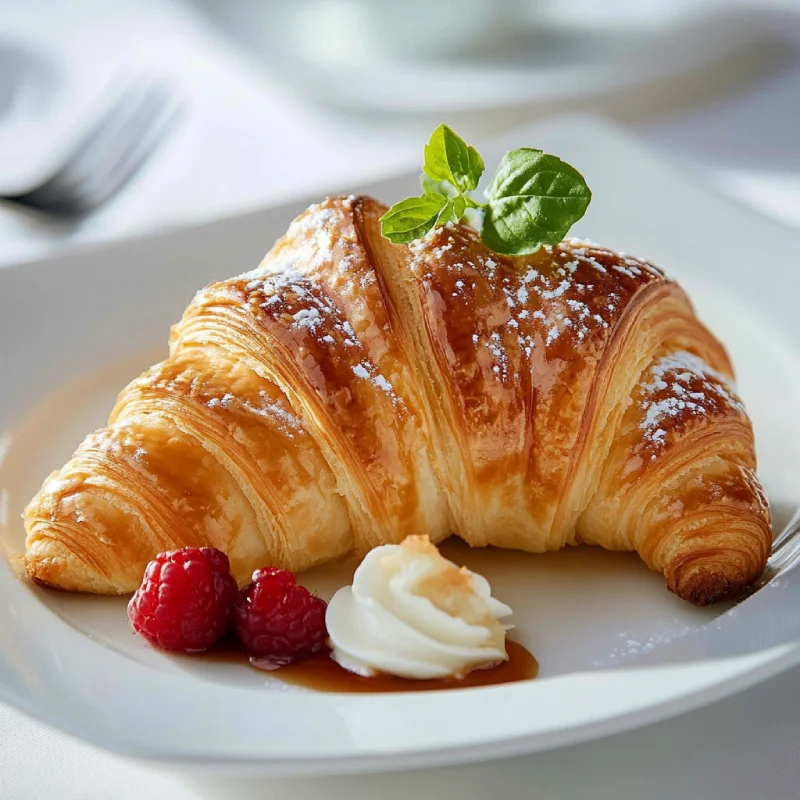Introduction to Gipfeli
What is Gipfeli?
Gipfeli, often regarded as the Swiss cousin of the French croissant, is a delightful pastry that has carved its niche in Swiss culinary tradition. Unlike the croissant, known for its light, airy texture, Gipfeli typically features a denser and somewhat richer feel, making it distinctively satisfying. This pastry not only reflects the finesse of Swiss baking but also holds a special place in the hearts of those in Switzerland, often enjoyed as a staple breakfast item or a snack during the day.
The history of Gipfeli is intertwined with Swiss culture, often linked to festive occasions and family gatherings, showcasing its cultural significance. Its crescent shape, which some say mimics the Swiss alps, adds a layer of national pride and craftsmanship to this beloved pastry. Gipfeli’s unique characteristics make it more than just food; it’s a symbol of Swiss heritage and culinary expertise.
The Making of Gipfeli
The creation of Gipfeli involves a meticulous process that combines traditional baking techniques with high-quality ingredients to achieve its unique texture and flavor. Here’s an overview of the process:
- Ingredients: The basic components include flour, butter, milk, sugar, yeast, and salt. The quality of butter is particularly crucial as it imparts the Gipfeli its characteristic flaky layers and rich flavor.
- Dough Preparation: The process begins with the preparation of a yeast dough, which is mixed and then allowed to rest. This initial rest is crucial for gluten development, which gives the dough its elasticity.
- Lamination: Similar to croissants, the dough for Gipfeli is laminated, meaning butter is incorporated through a series of folds and rolls. This technique creates thin layers of dough separated by butter, which, upon baking, results in the pastry’s flaky texture.
- Shaping: After the lamination, the dough is rolled out and cut into triangles, then each piece is rolled from the base to the tip to form the iconic crescent shape.
- Proofing and Baking: The shaped Gipfeli are then left to proof until they nearly double in size, which makes them light and airy once baked. Baking must be done at a high temperature to ensure a golden-brown finish and to maximize the lift and flakiness.
Mastering the art of Gipfeli requires patience and precision, but the result is a pastry that’s both rewarding and delicious.
Gipfeli Recipes and Variations
Basic Gipfeli Recipe
Making traditional Gipfeli involves a precise technique to achieve the perfect flaky texture. Here’s a step-by-step guide:
- Ingredients Gathering: Start with high-quality all-purpose flour, unsalted butter, yeast, milk, sugar, and a pinch of salt.
- Dough Preparation: Mix the yeast with warm milk and a little sugar to activate it. In a separate bowl, combine the flour and salt, then integrate the yeast mixture.
- Butter Lamination: Roll the butter between two sheets of parchment paper into a thin layer and chill. Roll out the dough and place the chilled butter sheet on top, folding the dough over it and sealing the edges.
- Folding and Rolling: Perform a series of folds and rolls—typically three sets of letter folds, chilling the dough between each set to maintain the butter’s consistency.
- Shaping the Gipfeli: Roll the final sheet to a thickness of about a quarter inch, cut into triangles, and roll each triangle from the base to the tip to form the crescent shape.
- Proofing: Allow the shaped Gipfeli to proof until they double in size, ensuring they become airy and ready for baking.
- Baking: Brush with an egg wash for a golden finish and bake in a preheated oven at 200°C (400°F) until golden and flaky, usually about 15-20 minutes.
Creative Variations of Gipfeli
Gipfeli, while traditional, can be adapted to suit a wide range of modern tastes and dietary needs:
- Sweet Variations: Incorporate fillings like chocolate, almond paste, or fruit preserves. Rolling small chunks of these fillings into the dough before shaping adds a delightful surprise to each bite.
- Savory Options: For those who prefer savory flavors, adding cheese, herbs, or even finely chopped ham can create a rich and satisfying pastry.
- Dietary Adaptations: Use gluten-free flour blends for those with gluten sensitivities or swap out dairy ingredients for plant-based alternatives like almond milk or vegan butter to cater to vegan diets.
Experimenting with these variations can transform the basic Gipfeli into a customized treat that appeals to all preferences.
Nutritional Information
Caloric Content and Health Considerations
Gipfeli, known for its buttery layers and delightful texture, does carry a certain caloric impact, primarily due to the high amounts of butter and flour used in its preparation. Typically, a single Gipfeli can range from 250 to 300 calories, with variations depending on the size and specific fillings used.
- Calorie Content: The majority of the calories in Gipfeli come from fats (primarily butter) and carbohydrates from white flour. These components make it a rich and indulgent treat best enjoyed in moderation within a balanced diet.
- Healthier Versions: To create a healthier version of Gipfeli, consider the following adaptations:
- Reducing Butter: Reduce the amount of butter or substitute part of it with a lower-calorie alternative like Greek yogurt to cut down on fat.
- Whole Grains: Swap traditional white flour with whole grain or whole wheat flour to increase the fiber content, which can help in managing blood sugar levels.
- Adding Nutritional Value: Incorporate seeds like flax, chia, or sunflower seeds into the dough to boost its nutritional profile with omega-3 fatty acids and essential minerals.
Serving and Pairing Ideas
How to Serve and Enjoy Gipfeli
Gipfeli, with their flaky, buttery texture and rich flavor, are a versatile pastry that can be enjoyed in various ways. Here are some recommendations on how to best serve and enjoy Gipfeli, whether you’re looking for a simple breakfast or an elegant dessert:
- Breakfast and Brunch: Serve warm Gipfeli with a selection of jams, honey, or butter for a classic breakfast. Pair them with a hot cup of coffee, tea, or a latte to start your day. Gipfeli can also be a star at brunch, complemented by fruits and cheeses, which balance the pastry’s buttery richness.
- Afternoon Tea or Coffee: Gipfeli make for a delightful afternoon treat. Pair them with a strong espresso or a delicate herbal tea. This combination is perfect for a relaxing break in your day, offering a satisfying crunch and a boost of energy.
- Savory Options: Although typically sweet, Gipfeli can be adapted for savory preferences. Consider serving them with ham and cheese, or filling them with pesto or tapenade for a lunchtime treat or a savory brunch option.
- Dessert: Elevate Gipfeli to dessert status by serving them with a scoop of gelato or drizzled with chocolate sauce. Pair with a dessert wine like a Riesling or Sauternes to complement the sweet and buttery flavors of the pastry.
- Special Occasions: For holidays or celebrations, Gipfeli can be dressed up with luxurious fillings like almond paste or dipped in chocolate and sprinkled with nuts or edible gold for a festive touch.
These pairing suggestions can help turn the simple act of eating Gipfeli into a memorable culinary experience.
FAQs
Frequently Asked Questions
Gipfeli, a beloved Swiss pastry, often raises several questions regarding its preparation, storage, and customization. Here are answers to some common queries:
- How should I store Gipfeli to maintain freshness?
- Gipfeli should be stored in an airtight container at room temperature. They are best enjoyed within 1-2 days of baking. For longer storage, you can keep them in the refrigerator for up to a week.
- Can Gipfeli be frozen for later use?
- Yes, Gipfeli can be frozen effectively. Wrap each pastry individually in plastic wrap and then place them in a zip-lock freezer bag. They can be frozen for up to 2 months. Thaw at room temperature or gently reheat in the oven when ready to serve.
- What are the best methods for reheating Gipfeli?
- To restore the pastry’s flakiness, reheat Gipfeli in an oven preheated to 350°F (175°C) for about 5-10 minutes. Avoid using a microwave as it can make the pastry soggy.
- How can I customize Gipfeli recipes for various dietary needs?
- For gluten-free options, substitute the regular flour with a gluten-free blend. For a dairy-free version, use vegan butter or margarine. To reduce sugar, consider using natural sweeteners like honey or maple syrup in moderation.
- Can I make Gipfeli without yeast?
- Traditional Gipfeli recipes require yeast, but for a quicker alternative, you can use baking powder. This variation will slightly affect the texture and taste but is useful for those short on time.
Conclusion
Exploring the world of Gipfeli offers a delightful glimpse into Swiss baking traditions, blending culinary craftsmanship with cultural heritage. Whether you are a seasoned baker or a curious foodie, Gipfeli provides a versatile canvas for both traditional and inventive baking:
- Culinary Heritage: Gipfeli, with its rich, buttery layers and distinctive crescent shape, is more than just a pastry; it’s a testament to Swiss precision and love for high-quality, comforting baked goods.
- Versatility in Baking: The adaptability of Gipfeli to incorporate various fillings and flavors makes it a favorite among those who enjoy customizing their baked treats to suit different tastes and dietary needs.
- Enjoyment Across Occasions: From a simple morning treat with coffee to a sophisticated addition to a brunch spread, Gipfeli fits beautifully into many culinary scenarios, enhancing each with its flaky, indulgent texture.
As you embrace the art of making Gipfeli, remember that each roll and fold brings you closer to mastering a pastry that has delighted palates for generations.

